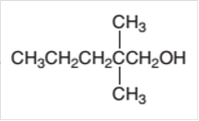
Concept explainers
(a)
Interpretation:
The following alcohol should be classified as primary, secondary and tertiary alcohol:

Concept Introduction:
Organic compounds are the compounds that are mainly composed of C and H atoms. The branch of chemistry that deals with the preparation, reactions, and properties of organic compounds are said to be
(b)
Interpretation:
The following alcohol should be classified as primary, secondary and tertiary alcohol:

Concept Introduction:
Organic compounds are the compounds that are mainly composed of C and H atoms. The branch of chemistry that deals with the preparation, reactions, and properties of organic compounds are said to be organic chemistry. The molecular formula of an organic compound represents the number of bonded atoms with their atomic symbols. The structural formula represents all the bonded atoms with chemical bonds and the arrangement of atoms in the molecule.
(c)
Interpretation:
The following alcohol should be classified as primary, secondary and tertiary alcohol:

Concept Introduction:
Organic compounds are the compounds that are mainly composed of C and H atoms. The branch of chemistry that deals with the preparation, reactions, and properties of organic compounds are said to be organic chemistry. The molecular formula of an organic compound represents the number of bonded atoms with their atomic symbols. The structural formula represents all the bonded atoms with chemical bonds and the arrangement of atoms in the molecule.
(d)
Interpretation:
The following alcohol should be classified as primary, secondary and tertiary alcohol:

Concept Introduction:
Organic compounds are the compounds that are mainly composed of C and H atoms. The branch of chemistry that deals with the preparation, reactions, and properties of organic compounds are said to be organic chemistry. The molecular formula of an organic compound represents the number of bonded atoms with their atomic symbols. The structural formula represents all the bonded atoms with chemical bonds and the arrangement of atoms in the molecule.
Want to see the full answer?
Check out a sample textbook solution
Chapter 14 Solutions
EBK GENERAL, ORGANIC, & BIOLOGICAL CHEM
- Arrange these compounds in order of increasing boiling point (values in C are 42, 24, 78, and 118). (a) CH3CH2OH (b) CH3OCH3 (c) CH3CH2CH3 (d) CH3COOHarrow_forward3. Complete the following intramolecular dehydration reactions for alcohols. Draw the structure of the product. Name the reactant and the product. a) Cy-C-CH-oH 18UC b) CHy CH-Cy-CHy 180C OH c) 180c 4. Complete the following intermolecular dehydration reactions for alcohols. Draw the structure of the product. Name the reactant and the product. a) CHy-CH-OH b) Ho SわふわSわ 5. Complete the following oxidation reactions for alcohols. Draw the structure of the product. Name the reactant and identify the type of compound formed in the product. a) hparrow_forward6. Draw a circle around the compound in each horizontal row with the highest boiling point and draw a rectangle around the compound with the lowest boiling point. HO, NH2 HO, HO HO, NH2 OH 1-pentanol 1-hexanol 1-octanol methanolarrow_forward
- Organic Reaction Write an equation for the oxidation of each alcohol. Use [O] above the arrow to indicate an oxidizing agent. If no reaction occurs, write "no reaction" after the arrow. 1. CH3CH2CH2CH2CH2OH CH₂ CH₂CCH₂CH₂ ОН CH CHCH CH CH CH, ОНarrow_forwardClassify each alkyl halide and alcohol as 1°, 2°, or 3°.arrow_forwardDrinking of too much alcohol cause liver cirrhosis because ethanol is converted to toxic * Acetone Ethanal Acetic acid Methyl ethanoate Ethers have lower boiling points compared to alcohols of comparable mass because they form dipole-dipole interaction among themselves. they cannot form hydrogen bond among themselves. they can form hydrogen bond with water. they are solvents in organic reactions. Dehydration of two molecules of methanol under acidic condition (H2SO4) at high temperature will produce * Acetone Ethanal Acetic acid Methoxymethanearrow_forward
- Which is NOT a physical property of alcohols or phenols? O Phenols are generally only slightly soluble in water. O The hydroxyl group of an alcohol is nonpolar. The solubilities of normal primary alcohols in water decrease with increasing molecular weight. Boiling points of normal primary alcohols increase with increasing molecular weight.arrow_forwardWhich of the following alcohols is the MOST soluble in water? O 2-methyl-2-pentanol O 4-methyl-2-pentanol O 3-methyl-1-butanol O 2-methyl cyclohexanolarrow_forwardClassify these alcohols as primary (1°), secondary (2°), or tertiary (3°). 1° 2° 3° CH,CH, CH,COH ČH,CH, OH CH,CHCHCH, CH, CH,CH, CH,CCH,OHarrow_forward
- Select the correct IUPAC name for the branched alcohol. OH HC OH CH CH CH CH CH HC CH CH The correct IUPAC name is: A) 3,4,6-trimethyl-4-propyl-2-heptanol B) 3,4,6-trimethyl-4-propyl-3-heptanol C) 2,4,5-trimethyl-4-propyl-5-heptanol D) 2-ethyl-3,5-dimethyl-3-propyl-2-hexanolarrow_forwardClassify each alcohol as 1 °, 2 °, or 3 °arrow_forwardPredict which member of each group is most soluble in water, and explain the reasons for your predictions. phenol, cyclohexanol, or 4-methylcyclohexanolarrow_forward
 Chemistry & Chemical ReactivityChemistryISBN:9781133949640Author:John C. Kotz, Paul M. Treichel, John Townsend, David TreichelPublisher:Cengage Learning
Chemistry & Chemical ReactivityChemistryISBN:9781133949640Author:John C. Kotz, Paul M. Treichel, John Townsend, David TreichelPublisher:Cengage Learning Organic ChemistryChemistryISBN:9781305580350Author:William H. Brown, Brent L. Iverson, Eric Anslyn, Christopher S. FootePublisher:Cengage Learning
Organic ChemistryChemistryISBN:9781305580350Author:William H. Brown, Brent L. Iverson, Eric Anslyn, Christopher S. FootePublisher:Cengage Learning

